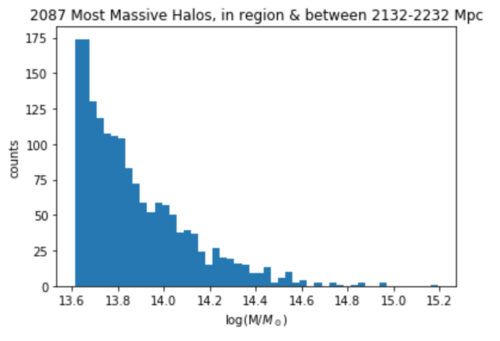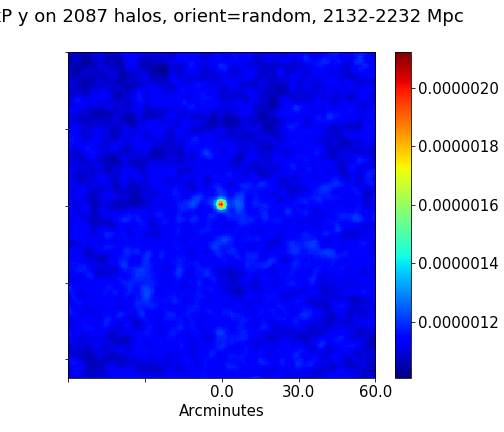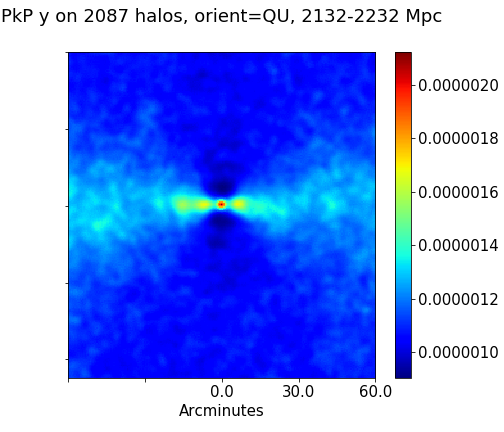Difference between revisions of "April 29, 2019"
| (11 intermediate revisions by the same user not shown) | |||
| Line 8: | Line 8: | ||
2) From this reduced catalog take an approximately Gaussian distribution of masses centered on logM = 12.87 (where M is in M_sun) with a standard deviation of 0.37, which should match the CMASS sample. See figure below. | 2) From this reduced catalog take an approximately Gaussian distribution of masses centered on logM = 12.87 (where M is in M_sun) with a standard deviation of 0.37, which should match the CMASS sample. See figure below. | ||
| − | [[File:Pkpatch bossgals masscut.png]] | + | [[File:Pkpatch bossgals masscut.png |500px]] |
3) Divide these halos into bins of 100 Mpc. For each bin, take a random sample of n halos, where n is the number of CMASS galaxies in that region of redshift space. | 3) Divide these halos into bins of 100 Mpc. For each bin, take a random sample of n halos, where n is the number of CMASS galaxies in that region of redshift space. | ||
| − | 4) For the clusters, take the sample left after step 1 and for every 100 Mpc bin, keep the top x halos. Here x is the number of DES Redmapper clusters in that region of redshift space. | + | 4) For the clusters, take the sample left after step 1 and for every 100 Mpc bin, keep the top x most massive halos. Here x is the number of DES Redmapper clusters in that region of redshift space. An example of the masses of these halos is below. |
| + | |||
| + | |||
| + | [[File:Massive halos.png|500px]] | ||
== Peak Patch stacks == | == Peak Patch stacks == | ||
| Line 34: | Line 37: | ||
2332 to 2432 Mpc: z = 0.619 to 0.652, 1280 RM clusters, 6260 CMASS galaxies | 2332 to 2432 Mpc: z = 0.619 to 0.652, 1280 RM clusters, 6260 CMASS galaxies | ||
| − | For orientation, I'm making number density maps of the 'clusters' and 'galaxies' and smoothing them to 1 degree. On the next iteration I could change this; we could choose a certain physical size and have the smoothing angular scale vary with each redshift bin to match that physical size. | + | For orientation, I'm making number density maps of the 'clusters' and 'galaxies' and smoothing them to 1 degree. On the next iteration I could change this; we could choose a certain physical size and have the smoothing angular scale vary with each redshift bin to match that physical size. Example below. |
| + | |||
| + | [[File:2132to2232 pkpatch.png | thumb |left| 700px | 2132 to 2232 Mpc number density map]] | ||
| + | |||
| + | |||
| + | |||
| + | |||
| + | |||
| + | |||
| + | |||
| + | |||
| + | |||
| + | |||
| + | |||
| + | |||
| + | |||
| + | |||
| + | |||
| + | |||
| + | |||
| + | |||
| + | |||
| + | The last step before stacking is I smooth the Peak Patch y map with a 2' beam to match with the ACT+Planck y map. | ||
| + | |||
| + | Here are some of the stacks. | ||
| + | |||
| + | [[File:PkptSZ halo random 2132 to 2232 Mpc.png]] | ||
| + | [[File:pkptSZ halo QU halo 2032 to 2132 Mpc.png]] | ||
| + | [[File:pkptSZ halo QU halo 2132 to 2232 Mpc.png]] | ||
| + | [[File:PkptSZ halo QU X UP halo 2032 to 2132 Mpc.png]] | ||
Latest revision as of 14:10, 30 April 2019
Peak Patch Halo Selection
These are the steps that I use to select halos from the full-sky high-redshift Peak Patch lightcone run.
1) Project all the halos onto a Healpix map. Keep only the ones that fall in the same sky regions I defined for the DES clusters and CMASS galaxies. I keep a larger rectangle of galaxies than of clusters because I don't want clusters on the edge to have strange orientation effects.
2) From this reduced catalog take an approximately Gaussian distribution of masses centered on logM = 12.87 (where M is in M_sun) with a standard deviation of 0.37, which should match the CMASS sample. See figure below.
3) Divide these halos into bins of 100 Mpc. For each bin, take a random sample of n halos, where n is the number of CMASS galaxies in that region of redshift space.
4) For the clusters, take the sample left after step 1 and for every 100 Mpc bin, keep the top x most massive halos. Here x is the number of DES Redmapper clusters in that region of redshift space. An example of the masses of these halos is below.
Peak Patch stacks
For now, I'm only doing stacks for the following high redshifts, since the lower-redshift bins are much less populated in both CMASS and RedMapper.
1632 to 1732 Mpc: z = 0.409 to 0.438, 1249 RM clusters, 2101 CMASS galaxies
1732 to 1832 Mpc: z = 0.438 to 0.467, 1290 RM clusters, 6560 CMASS galaxies
1832 to 1932 Mpc: z = 0.467 to 0.496, 1493 RM clusters, 9847 CMASS galaxies
1932 to 2032 Mpc: z = 0.496 to 0.526, 1486 RM clusters, 11968 CMASS galaxies
2032 to 2132 Mpc: z = 0.526 to 0.556, 1661 RM clusters, 12011 CMASS galaxies
2132 to 2232 Mpc: z = 0.556 to 0.588, 2087 RM clusters, 11443 CMASS galaxies
2232 to 2332 Mpc: z = 0.588 to 0.619, 1917 RM clusters, 9439 CMASS galaxies
2332 to 2432 Mpc: z = 0.619 to 0.652, 1280 RM clusters, 6260 CMASS galaxies
For orientation, I'm making number density maps of the 'clusters' and 'galaxies' and smoothing them to 1 degree. On the next iteration I could change this; we could choose a certain physical size and have the smoothing angular scale vary with each redshift bin to match that physical size. Example below.
The last step before stacking is I smooth the Peak Patch y map with a 2' beam to match with the ACT+Planck y map.
Here are some of the stacks.






